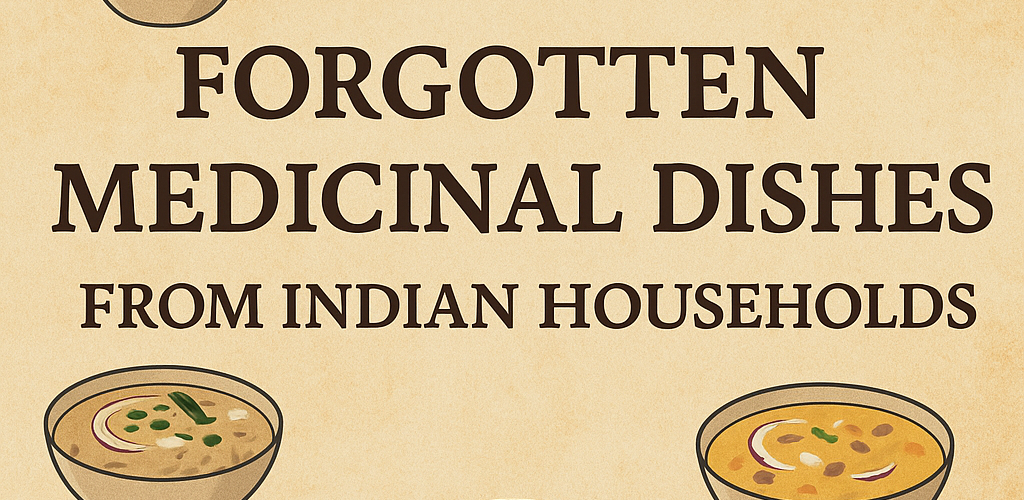Forgotten Medicinal Dishes from Indian Households

Indian kitchens once doubled as pharmacies. Long before prescription drugs and clinical pharmacies became accessible, households across the country relied on food as medicine. Grandmothers treated colds with spiced broths, healed indigestion with fermented gruels, and eased postpartum pain with energy-rich laddoos. These medicinal dishes carried centuries of empirical wisdom, passed down orally through generations. But in today’s fast-paced world, most of these recipes remain forgotten. Modern lifestyles replaced traditional meals with convenience foods, and clinical medicine eclipsed the therapeutic role of food. This article revisits some of these lost dishes, examining their ingredients, cultural context, and healing benefits—through the lens of taste, utility, and relevance today.
1. Kashayam (Herbal Decoctions)
Kashayams once sat beside every ailing child or coughing adult in a South Indian home. Mothers brewed these bitter potions using tulsi, pepper, cumin, ginger, ajwain, and jaggery. They targeted respiratory issues, fevers, or digestive troubles. Despite their unpalatable taste, their effectiveness never failed.
In today’s health-conscious era, people reach for packaged syrups or pills. Ironically, companies now bottle diluted versions of kashayams as “immunity boosters.” But the original, freshly brewed decoctions had far more concentrated benefits. Their disappearance marks a lost connection with intuitive, seasonal healing.
2. Kanji (Fermented Rice Gruel)
Fermented kanji acted as a natural probiotic, especially during gut infections, heatwaves, or post-fever recovery. Families in Tamil Nadu and Odisha often served this simple dish cold, with raw onions, green chilies, and sometimes curd. It cooled the body, replenished electrolytes, and restored microbial balance in the gut.
Kanji costs next to nothing, uses leftover rice, and doesn’t need much effort to prepare. Still, few urban households know about it today. Its subtle sour taste may not appeal to modern palates, but as a digestive aid, it still surpasses most commercial supplements. Taste-wise, it feels refreshing and grounding—especially when served with a side of pickle or roasted papad.
3. Sattu (Roasted Gram Flour Drink)
Sattu once powered laborers, athletes, and the ailing across Bihar and parts of Uttar Pradesh. Made from roasted gram flour, seasoned with black salt, jeera, lemon juice, and occasionally jaggery, sattu acted as a meal and medicine in one. It cooled the body, boosted energy, and supported digestion.
Today, protein powders and meal replacements dominate fitness culture. But none match the nutrient density and simplicity of a good sattu drink. In flavor, it offers an earthy, nutty richness with a touch of zing from lemon and spice. It deserves a revival not just for nostalgia, but for everyday nutrition and gut health.
4. Haldi Doodh (Turmeric Milk)
Before “turmeric lattes” made global headlines, Indian grandmothers served haldi doodh to heal wounds, improve sleep, and soothe inflammation. They simmered turmeric with milk, ghee, pepper, and sometimes a pinch of nutmeg.
The drink didn’t need fancy marketing; it simply worked. Its anti-inflammatory properties helped everything from joint pain to menstrual cramps. Yet, many now reject it due to changing taste preferences or reliance on painkillers. Taste-wise, haldi doodh provides warmth, a mild bitterness, and a creamy finish—a comfort drink, especially during winters or illness.
5. Gond ke Laddoo (Edible Gum Laddoos)
Postpartum diets across North India once included gond ke laddoo—a dense treat made from edible gum (gond), whole wheat flour, dry fruits, ghee, and herbs like ajwain and methi. These laddoos helped strengthen bones, improve lactation, and restore energy after childbirth.
In texture and taste, they combine crunch, sweetness, and richness. Today, very few young mothers consume them. The market sells them in stores occasionally, but mass production strips them of their medicinal precision. Homemade versions used exact dosages of herbs based on the woman’s body and climate—something that factory-packed sweets cannot replicate.
6. Khichdi with Hing and Ghee
Most people now eat khichdi as a comfort food. But its origins trace back to Ayurvedic cleansing diets. Cooked with minimal spices, a dash of asafoetida (hing), and generous ghee, this dish once treated constipation, indigestion, and fever fatigue.
Its simplicity carries medicinal wisdom. The moong dal provides easy-to-digest protein, the ghee acts as a digestive lubricant, and the rice restores carbohydrate balance. Even today, doctors advise a soft diet after stomach ailments—yet rarely do people realize khichdi’s ancient healing legacy. On the tongue, it offers a gentle, buttery warmth and light savory notes—a humble, healing bowl.
7. Raab (Rajasthani Bajra Gruel)
In arid regions of Rajasthan and Gujarat, people consumed raab—a thick gruel made from bajra flour, jaggery, and ajwain. They simmered it in water and let it ferment slightly. It treated colds, improved appetite, and provided warmth during winter.
This dish scores high on both flavor and nutrition. Bajra contains iron, fiber, and antioxidants, while ajwain supports respiratory health. The slight fermentation added a mild sourness that paired beautifully with jaggery’s sweetness. Unfortunately, most people today neither cook nor crave such humble, functional recipes.
8. Thambuli (Spiced Yogurt Herb Chutney)
Thambuli, from Karnataka, showcases how South Indian households once mixed medicine and flavor beautifully. Using herbs like doddapatre (Indian oregano), brahmi, or tulsi, they ground them with coconut, cumin, and curd to create a cooling chutney. Thambuli lowered body heat, aided digestion, and balanced pitta dosha.
Taste-wise, thambuli offers a cooling, herby tang—a refreshing side dish, especially in summer. The method doesn’t involve cooking, so it preserves the raw medicinal properties of herbs. Yet, this dish remains unknown to most Indians outside Karnataka today.
Conclusion
These forgotten medicinal dishes offer more than nostalgia—they represent a sustainable, affordable, and culturally rooted way of healing. Indian food once supported immunity, mental balance, and physical well-being without creating dependency on synthetic drugs.
The loss of these recipes signals not just a culinary gap, but a wellness crisis. Reviving them means reclaiming control over our health, our kitchens, and our identity. Fortunately, all it takes is curiosity, a trip to the local grocer, and perhaps a call to an elder who still remembers how to cook them.
Let’s bring these dishes back—not just to our plates, but to our lives.













